|
FLOID
|
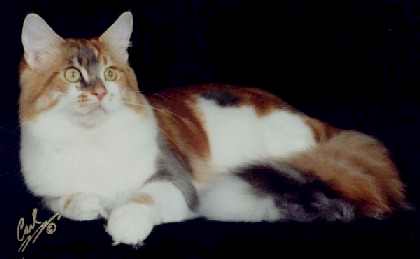
|
Solkatz Pretty Boy Floid, born 1996
Father: n 09 22; Mother: f 09 21.
|
|
The Seattle Times, November 1996:
"Solkatz Pretty Boy Floid, a triple genetic anomaly, is born in Bremerton, Washington. One of a litter of six Maine coon kittens, Floid was thought to be a female because his color, dilute calico (blue, cream and white), occurs 99-point-many-more-9s percent of the time on females. Floid's second surprise occurred when his breeders noticed that the cream portions of his coat were actually red. The chances of red, a nondilute color, finding its way into a blue coat, a dilute color, are 99-point-even-more-9s against. Seeing as how he was on a roll, Floid decided to go for the hat trick and be fertile, a condition found about point-37-zeroes-in-front-of-1 percent of the time in tricolored male cats.
For those budding geneticists in the audience, Floid is what is known as a chimaera. A chimaera results from a fusion of two fertilized eggs early in the embryonic stage, so Floid is actually two cats rolled into one. Budding classicists in the audience should know that a Chimaera [uppercase C intentional] is a fire-breathing she-monster in Greek mythology who has the head of lion, the body of a goat, the tail of a serpent and the voice of Rosie O'Donnell."
|
In 1998, Floid had already 27 kittens on his name, among which some champions. Since he stood at stud for a couple more years, he undoubtably has some more kits!
The colors of Floid's kittens suggested that their father was a red-with-white tom. Apparently his testicles were made by the red kitten, and there were no germ cells from the blue kitten. Remarkably, Floid never got a kitten with a diluted color: Floid showed dilution in his coat, but not in his sperm!
Floid has been extensively investigated, with the conclusion that he is a chimaera.
|
|
Celticoon Oleander
|
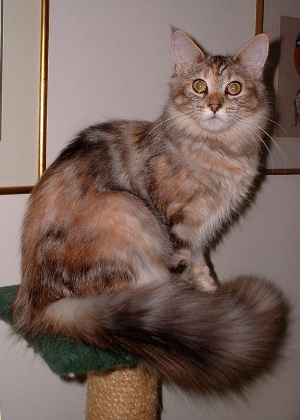
|
Celticoon Oleander
father: ns 09 21; mother: fs 22.
|
"Ollie is an unexpected addition to our family. It wasn't until he was 2 weeks old that we realised this beautiful silver tortie was a boy. Somehow we couldn't part with this sweet natured naughty tortie. We are hoping Ollie will become a companion for Tal when the girls are busy with kittens! As he can't be shown under the GCCF we hope to get Ollie out on exhibition later in 2006."
Ollie kan bewonderd worden bij Celticoon Maine Coons.
And who can resist such a lovely tortie kitten?
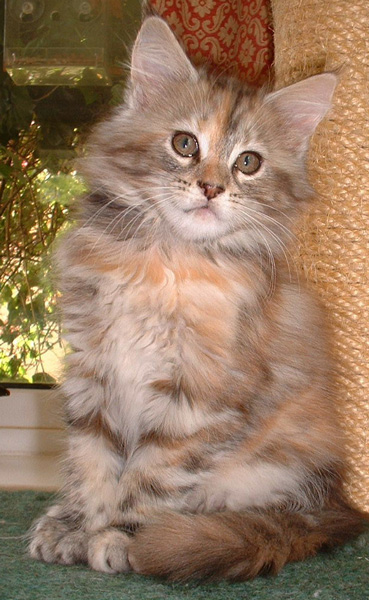
Ollie is also a Maine Coon. A beauty, that would take in many a judge! Because of a total lack of health-related problems, and a tortie mother, I'd suspect: a chimaera.
|
| |
|
|
|
GEEZER
|
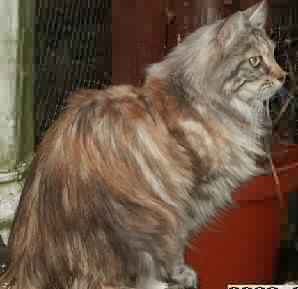
|
Koonikki Feirfiz Geezabird
father: ds 09 22; mother: n 22.
|
Fiona Nicholls tells us: "Geezer is a most adorable cat! He loves life and spends a lot of his day frog hunting around our pond. As he is quite clumsy he often falls into the pond.
Geezer was 6 weeks old before we realised he was male, as I didn't look to check - but I certainly do that now :o))!! He had to have an operation when he was 4 months old, and the vets looked for his reproductive organs. He had a gonad in ovary position, which turned out to be male tissue. Later on, when he was 10 months old, a testicle arrived in the right place. I was told that he most probably was an XXY and that he would not have been fertile at all.
Geezer has very maternal instincts as well as male ones. He adores kittens: he keeps a vigil outside my bedroom door when he knows there are new babies inside - he cannot wait to help mum look after them, he cleans and plays with them. Sometimes he also calls like a female to be mated, but on the other hand, he occasionally tries to mate a female (unsuccessfully).
Vespa (Geezer's dad) father is a very laid back cat and loves everyone feline and human, except Geezer! I find this very strange - perhaps Geezer doesn't smell correct to him? Anyway, he always hisses at poor Geezer.
Another interesting point: Vespa has just sired another Tortie male. A mating with a brown tabby female resulted in a litter of 5 kittens among which a tortie tabby male kitten. He is very brightly coloured and he wasn't confirmed as being male until the vet gave him his 1st vaccine at 9 weeks old. I don't know what the odds of this happening twice to the same male ???? All I know is that he is a very special boy."
Geezer can be admired at the homepage of Koonikki Maine Coons, where he has his own page!
Not a tortie, but 'plain' brown tabby (genetically black) mother! He must have gotten the red color from his father - or did a sister-to-be get the red? He can be a real Klinefelter, or a fusion, chimaera, between a tortie girl-to-be embryo and a brown boy-to-be embryo. Maybe his confusion does stem from this condition! And his half-brother? Did the red X-chromosome from the father again make its way together with the Y chromosome into the sperm and the egg, or another chimaera - or one of each??? There are chromosomal conditions that may make 'XY-sperm' more likely, so maybe Dad Vespa is, in another way, a very special cat! THANK YOU Fiona!
|
|
More stories
Usenet, 2001:
"My cats:
...
Toby=dilute tortie, male (yes, really! He was very macho male until we neutered him. I don't know if he was fertile or not. In fact he was still macho male after we neutered him. I once saw him mounting and humping the barn cat of our landlord 2 years after neutering!)"
This behaviour in an ex-tom is not unusual, but in the case of a tortie tom extra amusing. Lacking more information it is difficult to say what kind of tortie tom this guy was! In any case, it does not sound like he had any disabilities!
|
|
|
|
|
More stories
Usenet, 1996:
"I've observed a calico male (feral). He was physically male, but behaviorally female and took the female role in mating activities. Presumably he smelled like a female, because other toms were willing to mate with him (and not in a dominance context). He must have been an XXY individual, but when he died (FeLV/FIV or similar) we couldn't afford a PM, let alone a genetic investigation."
I disagree with the writer of this piece. In human Klinefelter patients nothing has been published about a tendency to female behaviour. No, they're not macho males - but definitely males, or at least, boys. The specific symptoms of any syndrome with an extra chromosome, depends also on the number, and the identity, of the genes on the extra chromosomes. And the genes on the X chromosomes in man and cat: well, some will be the same, but also some will be different!
It would also be possible that this cat is the result of a fusion between a girl-embryo and a boy-embryo. Because of the Y-chromosome, the embryo will develop the male organs, but maybe the girl has made the brains - and there the hormones (female, or male) are controlled, and the female cycle is regulated. Maybe this cat thought she was a female, only her partners might have wondered a bit .... Fertile? With female hormones sperm formation is impossible - even though it might have been possible as far as the chromosomes were concerned.
On the other hand: nobody knows anything of the symptoms of Klinefelter's syndrome in the cat. Apparently, at the time (1996) the veterinary science held that it would induce feminine behavior!
|
|
| |
|
Before or during fertilization
|
| |
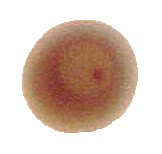
|
We start with an egg. This cell gets one X-chromosome from the mother. Either an X-chromosome with O - a 'red X'-chromosome -, or an X-chromosome with o - a 'black X'-chromosome. If the mother is black, then of course she cannot give a 'red X', but only a 'black X'. And if she is red, then she can only give a 'red X'. Only when she is tortie (or calico): then she can give either a 'red X', or a 'black X'. And if she is white? Well, consider the white as a coat over her colors - and although she may give this white coat, she will also give either a 'red X' or a 'black X'.
|
|
What can go wrong? Egg-formation can go astray, resulting in too many chromosomes in the egg, including possibly 2 X chromosomes.
|

|
Then a sperm cell comes seeking an egg. This cell has gotten from the father either an X-chromosome (with the color of the father!) and will make a female kitten, or a Y-chromosome, without color genes: but this sperm will make a male kitten.
|
|
What can go wrong? Just as in the case of the egg, sperm formation can go wrong, resulting in a sperm cell with extra chromosomes. And then we may get a sperm cell carrying both the X-chromosome and the Y-chromosome.
|
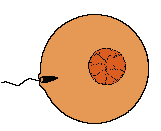
|
A sperm cell reaches the egg. Now the fertilized egg can have 'red X and 'red X' (red female kitten), 'red X' 'black X' (tortie / calico female kitten), 'black X' 'black X' (black female kitten). Or 'red X' Y (red male kitten) or 'black X' Y (black male kitten).
|
|
What can go wrong? As soon as one sperm is 'in', the egg closes itself off for other sperm cells, so that the egg is only fertilized by 1 sperm cell. But maybe 2 sperm arrived simultaneously?
|
| |
In all these cases, the fertilized egg starts with too many chromosomes. This is not good! Even a tiny amount of superfluous DNA is too much. Just remember the human world: patients with Down's syndrome have one of the smallest chromosomes extra - and if it were not for civilization, they would be severely handicapped! The sex chromosomes are the chromosomes that carry the smallest penalty: the Y chromosome because it is small and does not have much information, and the X chromosome - because mother nature knows how to handle an extra X chromosome! Doesn't every female carry one extra X chromosome compared to males?! So extra X chromosomes are inactivated, and the 'penalty' is much reduced.
What does that mean for this fertilized egg? Unless it looses all the extra chromosomes (with the possible exception of X and Y chromosomes, and maybe some other small chromosome), it is DOOMED: the egg probably degenerates and is resorbed even before implantation.
|
|
| |
|
After fertilization, before implantation
| |
| |

|
Everything went well: a succesfull fertilization, and a beautiful kitten-to-be! But: the egg is still close to the ovaries, and a long, long way away from the uterus. So now the eggs will 'drift', move towards the uterus, and to a nice comfy place. During this trip the egg divides, into 2 cells .... 4 cells .... 8 cells .... a lot of cells. And important things are also scheduled in this time: it is thought that in female embryo's one X chromosome will be inactivated, 'chosen' at random in each cell, when the embryo is about 1000 cells!
|
What can go wrong? The egg can choose the wrong way, and find itself in the belly outside the uterus: a very dangerous pregnancy!
Two balls of cells can touch each other. Maybe it is just a glancing blow, and maybe they exchange some cells during this incident. Maybe they fuse. If two 'black' embryo's bump into each other, who can tell? The only way we humans can tell (without DNA tests) is - if a 'red' embryo bumped into a 'black' embryo and the embryo's (or at least one of them) is male. Then we get a 'tortie tom'.
And what happens when a male embryo-ball fuses with a female embryo ball of cells? Maybe we humans don't notice anything, and maybe we get a very confused cat, once it is grown! The Y-chromosome will say: 'make male gonads, not female ones!' - but sex, or gender, is more than only gonads ... The brains also play a role, determining whether to arrange for a male cycle (yes! short ones!), or a female cycle.
|

|
By the time that these balls of cells arrive in the uterus, the uterus 'knows' that she has to take care of embryo's. But meanwhile the egg has divided into so many cells, that they form a sort of hollow balloon, with a clump of somewhat more cells on one side. This clump will form the final embryo and kitten! The outside of the balloon will form into membranes. These membranes guard the embryo and form, with mother cat, the placenta.
|
|
What can go wrong? Now the embryo's are sealed in their own bag - only identical twins may share the same bag!
|
| |
Compared to the dangers of egg formation, sperm formation, and fertilization, this seems rather safe - maybe a collision, but that is all. And indeed, collisions, ranging from 'head on' to 'glancing blows' seem to be the main danger. Of course, we don't know how many, or why, embryo's are resorbed during this trip.
Also, a (spontaneous?) somatic mutation may occur during this period.
|
|
| |
|
After implantation
| |
| |
Now there are only the 'normal' dangers of a pregnancy. The kittens can kick each other, mum cat can bounce off a table. Mom can get wrong food - she might even get poison, probably as 'medicine'. Maybe those are good for her, but not for the kittens. Anti-flea? Vaccinations? Garden fertilizer?
Also, a (spontaneous?) somatic mutation may occur during this period. Especially the allele for 'red', O, has a tendency to spontaneously change back into o, 'black'. Then the embryo has 2 kinds of cells: cells with 'red', and cells with 'black': the embryo is now called a 'mosaic'. The earlier in the embryonal development that this happens, the more cells will have the changed allele. And the more cells have the changed allele, the more we will see that. Not quite true: if that mutation occurs in cells that are destined to become, for instance, liver - well, we will not see that! But if those cells were destined, or become destined, to become color cells in the coat - then we can see it!
|
And how about fertility / sterility? If the sperm-cells to-be have an extra chromosome, X, Y, or any other, than those cells will NOT become sperm!!!! Really, fertility means that the spermatogonial cells are XY. Maybe some cells lost the extra X, and they were the cells that formed the testes, maybe by some other route, but: fertility means XY cells!
However, XY cells do not automatically mean fertility! There are other means of infertility: hormonal, sickness, ....
|
|
|
| |
|
I'll call the X-chromosome carrying 'O' red, even though it might cause crême. And the X-chromosome carrying 'o' I will call black - even though the colour might be brown, or blue, or cinnamon, or lilac, or fawn.
|
| |
|
|
parents
|
|
somatic mutation
|
Klinefelter XXY
|
Chimaera
|
|
|
red mother x red father
XO XO XO Y
|
|
TT
|
+
|
+
|
red mother x black father
XO XO Xo Y
|
TT
|
TT
|
TT*
|
|
tortie mother x red father
XO Xo XO Y
|
TT
|
TT
|
TT
|
tortie mother x black father
XO Xo Xo Y
|
TT
|
TT
|
TT
|
|
black mother x red father
Xo Xo XO Y
|
(TT)**
|
TT
|
TT*
|
black mother x black father
Xo Xo Xo Y
|
(TT)**
|
+
|
+
|
|
|
*: Only a fusion between a tortie girl-to-be embryo and a boy-to-be embryo may yield a 'tortie tom' in these cases. However, such a chimaera of embryo's of the opposite sex might very well be disturbed in sexual development and behaviour, and I would expect him to be sterile.
|
**: In these cases, a somatic mutation would show up as a red patch on a black male cat: this has never yet been seen, or at least, reported.
|
|
|
|
somatic mutation
|
Klinefelter XXY
|
Chimaera
|
|
+:
All possibilities mentioned above, are always possible! However, they do not always show! A somatic mutation on a tortie female? A chimaera of two black (or 2 red) embryo's? A Klinefelter (XXY) with the same color on both X chromosomes? We do not see them!
We do see them if the result is a Tortie Tom. Therefore I have labelled the possibilities which might cause a Tortie Tom, with TT.
|
|
Often 1, maybe 2 or even 3, rather small black patches.
Need not have other disabilities. However, if the mutations were induced during pregnancy by some (toxic) agent, then that same agent may have caused other mutations. And mutations are mostly bad!
No reason for sterility, unless as one of the 'other disabilities'.
|
Both colors need to be represented in the parents.
Distribution of red and black (as far as we know) similar to the distribution in a female cat.
Has also other disabilities, retarded?
Sterile, unless (maybe) 1 X was lost from the cells that were going to form the testicles.
|
For a normal tom, both colors need to be represented in the mother.
Possible if both colors are represented in the parents as a chimaera between embryo's of opposite sex.
Distribution of red and black might be anythying, and a chimaera of embryo's of the same sex ought not to have any disabilities, and would be fertile.
|
|
|
|
Want to hear it from somebody else? The story of mosaicism is told differently on Messybeast's interesting site.
|
|
|
I hope you all don't think I did all this by myself! A lot of friends -most with catteries of their own!- have helped me.
Anneke Kuijs -Patchwork-,
Ingrid Knobbe -Asana-,
Lies Klösters -Kindred Spirits-
and
Yolande Zandvliet -l'Hibou-
have helped me to locate the cats, find the people, find the information, and make it into a readable story! Thank you, guys!
Anne Guillon, Ans Rietveld, Cat Moody, Elvira Weidemann, Fiona Nicholls, Judy Miller, Nancy & Richard Koch, Sabine Straub, Sandra van Kluiven, Sarah Hartwell and Willie van Houwelingen allowed me to use photograph's of their cats and (or) shared their stories with me for this page. Colette Burnett, David Brinicombe, Gayla Pierce, Lucie Schagen, Renť Mooij, Sandra Musardo and Thom Bloks have supported me in other ways in making this page!
(Names listed in alphabetical order of given name :-)) )
|
|
|
Do you know any Tortie Toms? Do you have questions, or comments? Send me an
e-mail, and I'll be glad to answer!
|


 ).
).




